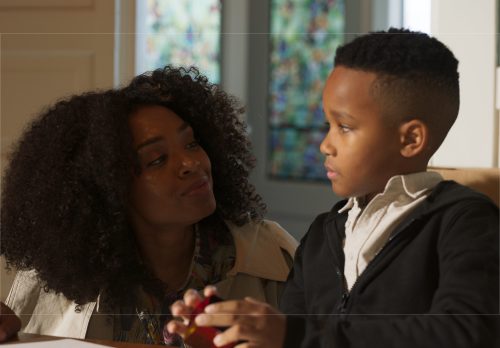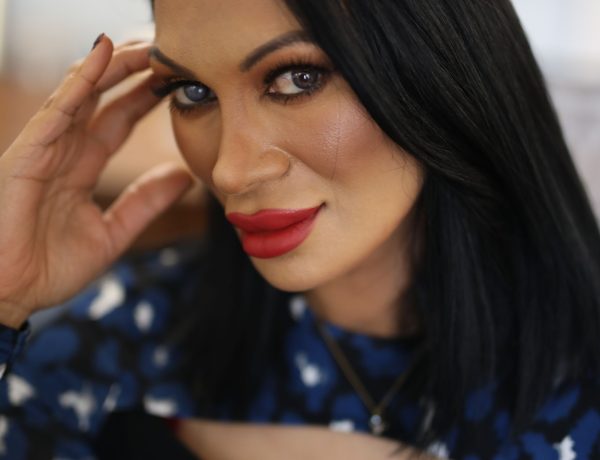Director Mostafa Keshvari was moved to create in the wake of the George Floyd tragedy. “I heard the news when I was painting at my studio, and all I could think of was how the pigment of his skin painted a different picture on the canvas of his faith. I just wished at that moment we could see everyone in one color: the color of humanity, and then the idea started to grow,” says Mostafa. That idea eventually became Colorblind, which chronicles a colorblind mother and son facing racial and social injustices. The film was a collaborative effort. “I was just the vessel that the universe chose to bring this story to collective consciousness with the help of the Black community, my amazing cast and crew. It was eye-opening to see how a few shades of lighter or darker skin can make us colorblind to our own racism and prejudice. Just as colorblind people are often not aware of their colorblindness until later in life, many racist people don’t think they are racist and are blind to it. This film, in a bigger picture, is about racism. The characters happen to be Black, and all the key creative people have faced racism in some way and come together to fight it with art.”
 Both main characters are colorblind as a symbolic lens through which to view racism. “I need to first thank the color scientist who worked on this project. This is the very first film to collaborate with color scientists to display colorblindness accurately,” Mostafa reveals. “I thought colorblindness could play a role in challenging the meaning of racism in an artful and symbolic way. I think none of us are born racist as children, and it’s taught by the system we are in, so I tried to address racism through the eyes of an innocent Black boy. The other reason was to put the audience in their perspective and see how the value of colors becomes meaningless when each person sees the colors differently.” The metaphor continues through the different degrees of colorblindness between mother Magdalene and son Monet. “Being a surreal painter at the Federation of Canadian Artists, I made Magdalene a tritanopia so she could still paint and imagine colors that she couldn’t see. She struggles to make a living as a painter, but her inability to see colors gives her an advantage in her imagination. Imagination is our most powerful tool to fight racism, to imagine a better world just like Dr. King had a dream and envisioned a better world. On the other hand, Monet, as a child, became the monochromatism type, the more extreme version that is seen only in black and white. This was done to show how children often see the world very abstractly and also to contrast with the racist neighbor who also sees everything in black and white symbolically.” Their racist landlord Walton represents the centuries of prejudiced policies that prevent Black families from achieving upward social and economic mobility. “The racist landlord is an example of systematic racism; he is someone who lives on the higher floor (upper society) and controls the land. The ownership of land in America has been one of the main factors in systematic racism, and I wanted to metaphorically address that by having Walton as a white landlord living above them but not being able to escape them as a neighbor.”
Both main characters are colorblind as a symbolic lens through which to view racism. “I need to first thank the color scientist who worked on this project. This is the very first film to collaborate with color scientists to display colorblindness accurately,” Mostafa reveals. “I thought colorblindness could play a role in challenging the meaning of racism in an artful and symbolic way. I think none of us are born racist as children, and it’s taught by the system we are in, so I tried to address racism through the eyes of an innocent Black boy. The other reason was to put the audience in their perspective and see how the value of colors becomes meaningless when each person sees the colors differently.” The metaphor continues through the different degrees of colorblindness between mother Magdalene and son Monet. “Being a surreal painter at the Federation of Canadian Artists, I made Magdalene a tritanopia so she could still paint and imagine colors that she couldn’t see. She struggles to make a living as a painter, but her inability to see colors gives her an advantage in her imagination. Imagination is our most powerful tool to fight racism, to imagine a better world just like Dr. King had a dream and envisioned a better world. On the other hand, Monet, as a child, became the monochromatism type, the more extreme version that is seen only in black and white. This was done to show how children often see the world very abstractly and also to contrast with the racist neighbor who also sees everything in black and white symbolically.” Their racist landlord Walton represents the centuries of prejudiced policies that prevent Black families from achieving upward social and economic mobility. “The racist landlord is an example of systematic racism; he is someone who lives on the higher floor (upper society) and controls the land. The ownership of land in America has been one of the main factors in systematic racism, and I wanted to metaphorically address that by having Walton as a white landlord living above them but not being able to escape them as a neighbor.”
Monet is heartbreaking proof that children of color don’t have the luxury of avoiding topics of racism. “I believe, as a person of color, you need to have those conversations earlier than you would have with white kids to protect your children. Through games and poetry, Magdalene (the mother) tries to indirectly teach her young son about racism. In the end, he will have to learn it the hard way and face the cold truth of the society he lives in.” Mostafa knows we have to work together to build a multiracial coalition. “I believe labeling itself can cause racism. Growing up in Iran, we had people of different colors, but never thought of racism within our own culture as we considered ourselves Persian regardless of color. I noticed every ethnic group is segregated and labeled, which in itself can lead us to think we are different. I believe by having more diversity in schools and getting children to be on the same team, we can slowly bond a friendship between children of different colors that could hopefully last a lifetime.” That is a future we can all get behind.
Read more Celebrity Interviews on ClicheMag.com
Director Mostafa Keshvari Scrutinizes Racism Through Lens of Colorblindness. Photo Credit: Courtesy of Project Four PR.




